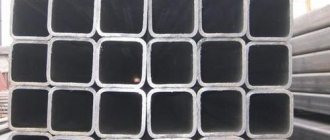What is a pipe?
A pipe is a hollow tube with a circular cross-section for transporting products. Products include liquids, gas, pellets, powders and more. The word "pipe" is used in contrast to tubing to refer to tubular products with dimensions commonly used for piping and piping systems. This site will discuss pipe sizes: ASME B36.10 Welded and Seamless Welded Steel Pipe and ASME B36.19 Stainless Steel.
Pipe and tube
In the world of pipes, the terms pipe and tube are used. A pipe is usually designated as a Nominal Pipe Size (NPS) and the wall thickness is designated by a Schedule Number (SCH).
A tube is usually defined by its outer diameter (OD) and wall thickness (WT), expressed in either Birmingham Wire Gauge (BWG) or thousandths of an inch.
Pipe: NPS 1/2-SCH 40 has a smooth outer diameter of 21.3 mm with a wall thickness of 2.77 mm.
Tube: 1/2″ x 1.5 flat to an outer diameter of 12.7 mm with a wall thickness of 1.5 mm.
The main applications for pipes are heat exchangers, instrument lines and small connections on equipment such as compressors, boilers, etc.
Pipe arrangement
The principle of sound of wind musical instruments lies in the vibrations and oscillations of the air column inside the tube. The longer it is, the more opportunities it gives the musician. The pipe has a length of up to 150 centimeters, but for reasons of compactness it is bent twice, reducing the length of the instrument to 50 cm.
The tube has the shape of a cylinder with a diameter of just over a centimeter; it gradually expands, turning into a bell. The manufacturing technology is complex. It is important to correctly calculate the degree of expansion of the bell so that it matches the length of the main channel.
Interestingly, there is the longest pipe in the world with a length of 32 meters and a bell diameter of more than 5 meters. It is clear that a person will not be able to play on it. Air is supplied to the channel using a compressor.
The instrument consists of three parts: mouthpiece, tube and bell. But this is a primitive and far from complete idea of the instrument. In fact, there are more important components in it. Details include:
- mouthpiece – connects the embouchure to the main channel;
- first, second, third and tuning crowns - with the help of the general crown and its extension, the instrument is tuned, the rest are used for maintenance;
- valves – a system of valves, when closed, the sound effect changes;
- drain valve is a technical device that is not involved in sound production.
The tubes and components of the instrument are made mainly of copper and copper alloys; the body is given shine by varnish, nickel or silver coating.
Galvanized steel
Galvanized steel parts are more reliable, but this is reflected in their cost. They are resistant to temperature changes and, thanks to the protective zinc layer, are resistant to corrosive influences. However, the protective layer may be damaged for one reason or another (from impacts) and then rust will appear in the places where it has broken off.
Pipes with a protective zinc coating are not afraid of corrosion, so they last longer than usual
Such pipes are used in cases where it is necessary to install a durable structure that will not be subject to pressure changes and temperature changes. Galvanized steel parts are ideal for temporary structures in harsh operating conditions.
History of the instrument
Wind instruments appeared long before the invention of melodic instruments. It is known that people learned to blow trumpets three centuries BC. In ancient Egypt, there was a special technology by which pipes could be made from a single sheet of metal.
During excavations in Egypt, pipes made of wood and shells were discovered. And in the tomb of Tutankhamun, tools made of silver and bronze were discovered.
In the Middle Ages, all troops were equipped with trumpeters; their main task was to transmit command orders to army units. During the breaks between wars, the instrument was used to attract the attention of spectators at knightly tournaments and festivals. Its sound notified city residents about the arrival of important people or the need to gather in the square to announce decrees.
During the Baroque era, European academic music began to flourish. The sound of the trumpet is included in orchestras for the first time. Despite the fact that the instrument allowed only the diatonic scale to be played, musicians appeared who masterfully mastered the technique by changing the position of the lips.
But at the end of the 18th century, string and melodic instruments flourished, and the trumpet, limited in its performance capabilities, faded into the background in the orchestra. It begins to sound actively again only closer to the middle of the 19th century. By this time, the craftsmen had improved the design by introducing a valve system of three valves. They expanded the capabilities of the instrument, allowing it to change the scale, lowering the sound by a tone, a semitone and a tone and a half. The trumpet gained the ability to extract a chromatic scale, and after a number of improvements to the device, the problem of fluency and changes in timbre was solved.
The history of the brass musical instrument knows many outstanding trumpeters. Among them is Maurice Andre, recognized as the “trumpet player of the 20th century.” He treated the trumpet as one of the main concert instruments, taught at the Paris Conservatory, and recorded more than 200 discs. Other famous trumpeters include Louis Armstrong, Freddie Hubbard, Sergei Nakaryakov, and Arturo Sandoval.
Installation work on the VGP pipe
When laying VGP, specialists usually use the following methods:
- Connection with couplings using various equipment. This connection method is only allowed when ordinary walls are available;
- Electric welding connection.
Installation features
VGP connection work
Let us summarize our reasoning and the above data. Despite the craze for modern polymer, high-tech wire materials, due to their excellent characteristics that are optimal for this field of application, VGP pipes are in demand and, most likely, will be in use for many years.
Scale, range, registers
The main trumpet in the orchestra is in the B-flat - C tuning. Notes are written in the treble clef one tone higher than the actual sound. In the lower register, the instrument produces a gloomy sound, in the middle – soft (piano), militant, persistent (forte). In a high register, the trumpet calls the listener with a ringing, bright sound.
In the middle register, the trumpet exhibits remarkable passage capabilities and, thanks to its technical flexibility, allows arpeggios to be composed.
In Europe and America, the “analogue” of this instrument in the “C” tuning is most widespread. Western musicians find many advantages in its use, ease of sound production in the upper register and the ability to realize the range from “E” of the small octave to “C” of the third.
One of the varieties is piccolo.
Types of pipe
Other types of pipes are less commonly used:
- alto – a variety used to produce sounds of a low register, “G” tuning, often in a symphony orchestra this type replaces the flugelhorn;
- piccolo - an improved model with an additional valve, adjustable to “G” or “A”, has a small mouthpiece;
- bass – tuned to “B”, but can sound an octave lower than a regular trumpet.
In modern symphony orchestras, the bass trumpet is almost never used; it is replaced by the trombone.
Bass
Playing technique
The performer holds the instrument with his left hand and acts on the valve system with his right. To learn how to play, you need to understand that the extraction of harmonics occurs due to the embouchure, that is, changing the position of the lips, tongue, and facial muscles. During sound production, the lips acquire a certain rigidity and become tense. In the process, the musician reduces the sound using valves.
Due to the fact that the flow of breath while playing music on the trumpet is small, the instrument allows you to perform various techniques, passages, and arpeggios. Brilliant staccato variations are realized in the middle register.
Professionals actively use special devices called mutes and inserted into the bell. Depending on the shape of the mute, the trumpet will sound quieter or louder. So in jazz they most often use “fungus”, which makes the sound soft, velvety.
Principles of production of VGP pipes and GOST
Carbon steel is used for water and gas pipes. The technology of their production fits into several stages, which are quite simple and technologically determined.
- Production of strips - steel blanks in the form of strips with a thickness and width that meet the requirements of GOST. Strips are made by hot rolling.
- The steel strip is bent into a pipe using special equipment.
- The resulting joint is welded using electric welding.
As you can see, there is nothing complicated from a technology point of view. The qualitative characteristics of VGP pipes are set out in GOST 3262-75, but, it must be said, quite stringent requirements are imposed on water and gas pipes, since they will have to operate under conditions of high loads and fairly harsh environmental conditions. Particular attention is paid to the weld: it is necessarily checked by radiography for integrity and absence of gaps. In this case, seam defects are unacceptable!
In addition, VGP steel pipes must meet the following requirements:
- absence of swellings, declines, cracks, chips on the surface;
- absence of delaminations and cracks at the ends of the water and gas supply material;
- cutting should be done at right angles; deviation from it is allowed no more than 2 degrees;
- burrs after cutting should not exceed 0.5 mm.
GOST allows the presence of minor defects on the VGP pipe, such as ripples and dents, but only if their presence does not affect the performance of the product.
Anti-corrosion characteristics are an important detail
The next indicator is the ability of this material to resist rust. To improve the anti-corrosion characteristics of the product and extend their service life, the industry produces galvanized pipes. GOST regulates the thickness of the coating: the minimum zinc layer is allowed to be 30 microns. It may be absent exclusively at the ends. The entire remaining area of the pipe is carefully covered.
There are certain requirements for the galvanized surface as a whole. It should be smooth, without peeling, blistering or inclusion of foreign materials. Rust should not get through possible micro-holes, so this process is also scrupulously controlled by engineering methods.
For heating installation
Using a pipe
A large orchestral instrument is used in music to give it a dramatic character and to create tension. The sound is quite expressive, even if it sounds quiet. Therefore, the trumpet in the compositions represents heroic images.
Nowadays, trumpeters can perform solo or form entire orchestras. In 2006, an ensemble of 1,166 trumpeters performed in Oruro, Bolivia. It is included in musical history as the most numerous.
The instrument is used in various musical genres. He is a permanent member of jazz, symphony and brass orchestras, and his sounds always accompany military parades.
Precision groups and some other additional parameters
For the assortment and selection of VGP pipes, there are also so-called accuracy groups. There are only two of them:
- standard precision pipes;
- high precision products.
Pipes of the first type are made from steels whose characteristics are given in GOSTs 380 and 1050. In this case, neither the chemical composition nor the mechanical parameters are standardized. Standard precision steel pipes are used in domestic gas and water supply systems, as well as in heating systems during the construction and repair of residential and industrial premises, for organizing gas and water supply in summer cottages and private areas.
When producing high-precision products, the manufacturer is guided by GOST 1050; rationing is also not carried out. Pipes of this category are used for structural parts transporting water and gas.
- Wall thickness divides pipes into three more categories: lightweight pipe products, ordinary products and reinforced ones. The wall thickness is regulated by the provisions of GOST 3262-75. The last two types of steel pipes can, at the request of the consumer, be equipped with threads at both ends of the product (if the nominal bore of the pipe is 10 mm or more).
- The complete set of pipe rolling can also be different. A delivery option is available without a coupling and without a thread; it is also possible to obtain pipes with both.
Famous trumpeters
The most famous were the musicians who mastered brilliant technique. Among the virtuosos who have dedicated their lives to promoting the instrument is Arturo Sandaval, who studied it from the age of 12 and received 10 Grammy awards during his life.
American trumpeter Clark Terry left his mark on jazz culture. He performed all over the world, gave free lessons, and had a unique technique and virtuosity.
In 1955, the trumpet of another jazz legend, Dizzy Gillepsie, was sold at Christie's auction. The famous instrument was branded "Martin Committee" and was sold for $55,000.
Everyone knows the story of a guy from a poor New York family, Louis Armstrong. His fate was difficult, as a teenager he committed crimes, stole and could have spent his whole life behind bars. But one day at the correctional facility I heard a trumpet and became interested in studying the instrument. His first concerts were street performances, but very soon Armstrong became one of the most famous performers, distinguished by his brilliant technique. Louis Armstrong gave the world a unique musical jazz heritage.
Musical instrument: Trumpet
The trumpet has been used since ancient times as a signaling musical instrument; due to its piercing sound, it notified in time of danger, attracted attention and supported military courage. And in the Polish city of Krakow, there is still a story about a hero-watchman who, despite being wounded, was able to warn residents of the impending danger. He managed to signal in time that the enemy army was approaching through the copper pipe, but he never finished the game. Until now, in this city, the call sign is a melody that suddenly ends at the last sound.
As it improved, the trumpet began to occupy an increasingly significant place in musical culture. Initially having the ability to perform only individual notes, it eventually developed into a full-fledged instrument, for which many composers began to compose individual works.
the history of the trumpet and many interesting facts about this musical instrument on our page.
Trumpet sound
Clear, expressive, brilliant, sometimes even piercing - this is how you can describe the voice of a trumpet. It has a characteristic rich timbre that gives the orchestra a majestic and pathetic sound. The sound of the trumpet is also used to give the music a dramatic character when internal tension reaches its climax. The voice of this instrument creates heroic, strong-willed and courageous images; it can sound very quiet and soft, but at the same time surprisingly powerful when voicing battle scenes.
The range of the trumpet is from E of the small octave to D of the third octave, but this is not the limit; the skill of the musicians allows it to be slightly increased.
To expand the means of artistic expression, trumpeters very often use a mute - a device that is shaped like a pear. Its main purpose is to change the strength of sound and some sound effects. Thus, on a trumpet, a “forte” with a mute sounds defiantly bold, and a “piano” gives the effect of sounding at a distance. With the help of the mute, the instrument can produce meowing, croaking and growling sounds, and it also helps the musician create different images: from harsh and gloomy to unusually tender.
The trumpet is a technically flexible instrument on which the performer, depending on his skill, can masterfully play the most complex passages and various trills.
Photo:
Interesting Facts
- The trumpet may appear to be a small and compact instrument compared to larger instruments such as the trombone or horn , but when straightened out, the trumpet is approximately 190 cm long, which is taller than the average person.
- The earliest pipes were made from a variety of materials, including shells and wood.
- The largest pipe has a length of 32 meters, the diameter of the socket is 5.2 meters. The sound on it is reproduced using an air compressor.
- The trumpet was played by such celebrities as James Hunt (racing driver), Richard Gere (actor), James Wood (actor), Justin Bieber (singer), Steven Tyler (rock musician), Samuel L. Jackson (actor), Paul McCartney (Beatles) ), Jayne Mansfield (Actress).
- The highest note ever played on the trumpet is C in the fourth octave.
- Two trumpets, one silver and the other bronze, were found in the tomb of the Egyptian pharaoh Tutankhamun. There have been suggestions that they have magical powers and their sound can cause the outbreak of war. These instruments were played in 1939, shortly before World War II, the trumpets were also played before the Gulf War in 1990, and the bronze trumpet was played again recently, one week before the Egyptian revolution in 2011.
- The first trumpet factory was founded in 1842 in Paris by the outstanding designer of musical instruments, Adolphe Sax.
- The largest trumpet ensemble, with 1,166 members, performed at a concert organized in the city of Oruro, Bolivia, on February 19, 2006. The trumpet ensemble was part of a large event with the participation of 5,000 different musicians.
- The longest string of trumpeters consisted of 105 performers and was used as part of an event organized at the football stadium in Eveleigh, UK, on September 7, 2014.
- In Japan, Toyota developed the world's first robot that can play the trumpet in 2005.
- Tromba - this is what the Italians call the trumpet, trompette - the French, die Trompete - the Germans, trumpet - the Americans.
- The famous Marten Committee trademark curved bell trumpet that belonged to jazz legend Dizzy Gillepsie was auctioned at Christie's in 1995 for $55,000.
Works for trumpet
I. Haydn - Concerto for trumpet and orchestra in E-flat major (listen)
G. Tomasi - Concerto for trumpet and orchestra (listen)
Pipe design
Modern pipes are made of brass - a special alloy of copper and zinc, then coated with varnish or galvanic coating containing silver, nickel, and less often gold. In addition to brass, pipes are made of silver, copper, and sometimes gold.
The trumpet has the shape of a thin cylinder, which remains unchanged along its entire length, which gives the instrument its characteristic live sound. On one side the pipe has an expanded cup-shaped hole - this is the bell, on the other - the mouthpiece.
This instrument, folded in half into an oval shape, seems very compact, but if it is straightened, the length will be 1.5 meters, and sometimes more.
The pipe consists of the following elements: main crown, bell, additional crowns, valves, mouthpiece.
A trumpeter can produce 45 different sounds with just 3 valves.
Application
The trumpet is a versatile musical instrument. The range of its application is very diverse - symphony, brass, pop orchestras, jazz, funk, ska - jazz, rock and many other musical styles. The timbre of the trumpet is bright, clear, slightly harsh, and very often attracted the attention of composers of different eras. I.S. Bach , L.V. Beethoven , J. Brahms, F. Liszt , C. Debussy, D. Verdi , J. Bizet. D. Gershwin, G. Mahler, M. Mussorgsky , M. Ravel, N. Rimsky-Korsakov , A. Scriabin, D. Shostakovich, P. Tchaikovsky , D. Verdi and many others trusted the trumpet with solo moments. The trumpets sounded in solemn, heroic, and sometimes lyrical episodes.
In a brass orchestra, the trumpet plays a leading role; like the violin in a symphony orchestra, it plays the first voice.
The prima trumpet is also used in jazz music. She became the symbol and soul of jazz when such varieties of the genre as Dixieland, New Orleans jazz, Chicago school, etc. appeared.
Repertoire and famous performers
The trumpet technique and its expressive capabilities are very great, and, admiring its beautiful and rich sound, composers willingly wrote their works for it. Of particular note are the concert works of J. Haydn , J. Hummel, A. Goedicke, S. Vasilenko, A. Harutyunyan, A. Pakhmutova, M. Weinberg, A. Tomasi, R. Shchedrin, B. Blacher.
The performing repertoire for the trumpet is very rich. Composers in their works have shown that this instrument is as virtuoso as a violin, as gentle as a human voice and has the stylistic plasticity of a piano, and famous virtuoso performers such as M. Andre, L. Armstrong , D. Gillespie, T. Dokshitser, K. Brown, M. Davis, S. Nakaryakov, C. Baker, A. Sandoval, E. Calvert, G. Orvid, W. Morsales, F. Hubbard and many others proved this with their skill.
How to choose a trumpet for a child
The trumpet is an instrument that undoubtedly attracts close attention, including from children. If a child heard a trumpet and expressed a great desire to learn how to play this instrument, what should parents know? Firstly, it is best not to rush into learning the trumpet; you need to start at the age of 10-12 years, the child’s body should already be sufficiently developed: good lung capacity, developed articulation and ear for music. Learning to play the trumpet is not easy; the trumpeter does not see the keyboard, but can only mentally imagine it. The child must be ready, although not for long, but systematic lessons, only then will the instrument be submissive in the hands of a young musician. If your child is still young enough to start playing the trumpet, you can avoid delaying the initial period of musical education and first master an instrument that is more appropriate for their age, such as the piano or recorder. This will be a very good base - the child will become familiar with musical literacy, develop hearing, memory and attention.
Trumpet practice, as doctors say, has a very beneficial effect on health: it strengthens the lungs and nervous system. Restless and unbalanced children turn into calm and self-possessed ones.
Learning must begin on a good instrument, with a pleasant timbre, soft and easy mechanics. Companies that produce pipes of various modifications are AMATI, BACH, BOSTON, BRAHNER, CONN, KING, ROY BENSON, VESTON, YAMAHA. Most models designed for beginning musicians and students are of fairly high quality and at a reasonable price.
Pipe history
The history of the trumpet begins in ancient times; information about this instrument comes to us from the Ancient World: Egypt, Greece, India, China. Antique drawings have been preserved depicting people playing the trumpet,
For most of its existence, this instrument could produce only one or two sounds and served primarily as a fanfare for special occasions: court ceremonies, jousting tournaments, announcing the arrival of important guests, royal weddings. The trumpet also accompanied religious ceremonies or military operations; its sound was clearly audible over long distances and through the roar of battle. The trumpets were played by specially trained people who were treated with great respect.
Until the 14th-15th centuries, these instruments were quite long, and it was very inconvenient to play them, then the pipes began to twist and the instrument acquired its characteristic shape. But these were still natural pipes, without valves, which could only produce the sounds of a natural scale.
In the 16th century, craftsmen from Nuremberg, Germany began making and distributing these instruments throughout Europe. And at the end of the century, trumpets began to be used in musical works, first in the low register, and then in the upper register.
During the 17th and 18th centuries, the natural trumpet reached the height of its development and was used with great success as part of the opera orchestra. We meet it in the works of Handel and many other composers. The role of the trumpet at that time was very modest: simple, short melodies based on the sounds of triads, signals and participation in harmonic accompaniment. Folded in a traditional form, the length of the instrument varied from 1.8 to 2.5 m.
A very important event in the history of the pipe was its mechanical improvement, invented in 1814 - valves. On the trumpet it became possible to perform a chromatic scale, as well as to intonate more accurately. The sound became more colorful and stronger. In 1832, the pipe was further improved: the valves were replaced with pump valves. The chromatic trumpet was introduced into the orchestra for a very long time, as composers treated it with great caution. Only in 1831 did the new trumpet become part of the orchestra, and the first to recognize its merits was R. Wagner .
The trumpet is an amazing musical instrument that attracts attention and captivates listeners from the first sound. Not only does it have a glorious history and is distinguished by the versatility of its use, the trumpet is capable of filling the entire universe with its magical sound. You can talk about all the advantages of this instrument, its unique timbre or its rich performance technique, for a very long time, but the best thing is to just listen to how it sounds.
Did you like the page? Share with your friends:
Pipe











